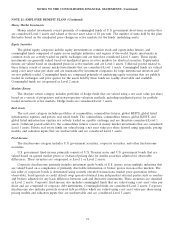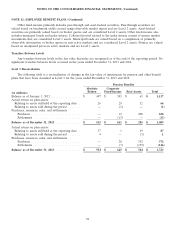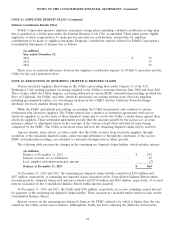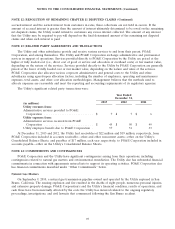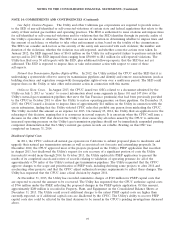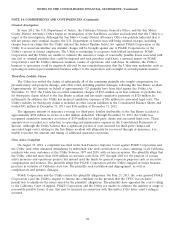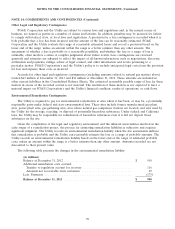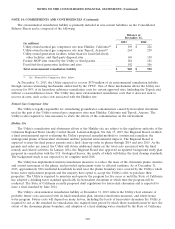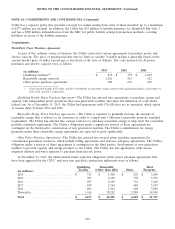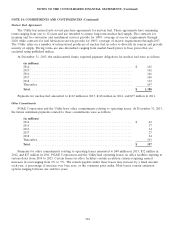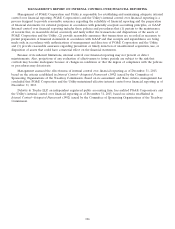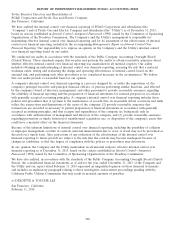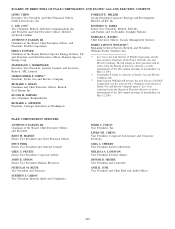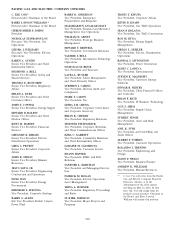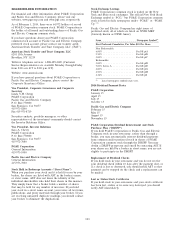PG&E 2013 Annual Report Download - page 107
Download and view the complete annual report
Please find page 107 of the 2013 PG&E annual report below. You can navigate through the pages in the report by either clicking on the pages listed below, or by using the keyword search tool below to find specific information within the annual report.NOTES TO THE CONSOLIDATED FINANCIAL STATEMENTS (Continued)
NOTE 14: COMMITMENTS AND CONTINGENCIES (Continued)
Future changes in cost estimates and the assumptions on which they are based may have a material impact on future
financial condition, results of operations, and cash flows.
Topock Site
The Utility’s remediation and abatement efforts at the Topock site are subject to the regulatory authority of the
California Department of Toxic Substances Control and the U.S. Department of the Interior. The California
Department of Toxic Substances Control has approved the Utility’s final remediation plan to contain and remediate
the underground plume of hexavalent chromium, under which the Utility will implement an in-situ groundwater
treatment system to convert hexavalent chromium into a non-toxic and non-soluble form of chromium. The Utility
expects to submit its final remedial design plan in 2014 for approval to begin construction of the groundwater
treatment system. The Utility has implemented interim remediation measures, including a system of extraction wells
and a treatment plant designed to prevent movement of the chromium plume toward the Colorado River.
The Utility’s environmental remediation liability at December 31, 2013 reflects its best estimate of probable
future costs associated with its final remediation plan. Future costs will depend on many factors, including the extent
of work to be performed to implement the final groundwater remedy and the Utility’s required time frame for
remediation. Future changes in cost estimates and the assumptions on which they are based may have a material
impact on future financial condition, results of operations, and cash flows.
Reasonably Possible Environmental Contingencies
Although the Utility has provided for known environmental obligations that are probable and reasonably
estimable, the Utility’s undiscounted future costs could increase to as much as $1.7 billion (including amounts related
to the Hinkley and Topock sites described above) if the extent of contamination or necessary remediation is greater
than anticipated or if the other potentially responsible parties are not financially able to contribute to these costs.
The Utility may incur actual costs in the future that are materially different than this estimate and such costs could
have a material impact on results of operations during the period in which they are recorded.
Nuclear Insurance
The Utility is a member of NEIL, which is a mutual insurer owned by utilities with nuclear facilities. NEIL
provides insurance coverage for property damages and business interruption losses incurred by the Utility if a nuclear
event were to occur at the Utility’s two nuclear generating units at Diablo Canyon and the retired Humboldt Bay
Unit 3. NEIL provides property damage and business interruption coverage of up to $3.2 billion per nuclear incident
and $2 billion per non-nuclear incident for Diablo Canyon. Humboldt Bay Unit 3 has up to $131 million of coverage
for nuclear and non-nuclear property damages.
NEIL also provides coverage for damages caused by acts of terrorism at nuclear power plants. Certain acts of
terrorism may be ‘‘certified’’ by the Secretary of the Treasury. If damages are caused by certified acts of terrorism,
NEIL can obtain compensation from the federal government and will provide up to its full policy limit of $3.2 billion
for each insured loss. In contrast, NEIL would treat all non-certified terrorist acts occurring within a 12-month
period against one or more commercial nuclear power plants insured by NEIL as one event and the owners of the
affected plants would share the $3.2 billion policy limit amount.
Under the Price-Anderson Act, public liability claims that arise from nuclear incidents that occur at Diablo
Canyon, and that occur during the transportation of material to and from Diablo Canyon are limited to $13.6 billion.
The Utility purchased the maximum available public liability insurance of $375 million for Diablo Canyon. The
balance of the $13.6 billion of liability protection is provided under a loss-sharing program among utilities owning
nuclear reactors. The Utility may be assessed up to $255 million per nuclear incident under this program, with
payments in each year limited to a maximum of $38 million per incident. Both the maximum assessment and the
maximum yearly assessment are adjusted for inflation at least every five years. The next scheduled adjustment is due
on or before September 10, 2018.
The Price-Anderson Act does not apply to claims that arise from nuclear incidents that occur during shipping of
nuclear material from the nuclear fuel enricher to a fuel fabricator or that occur at the fuel fabricator’s facility. The
101


